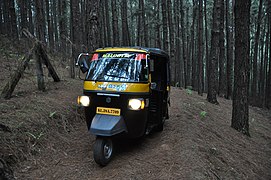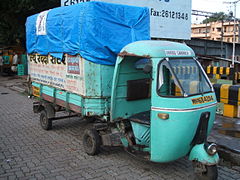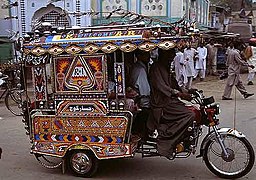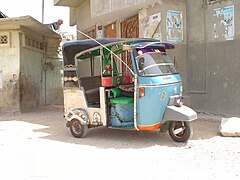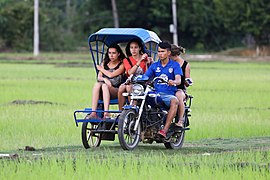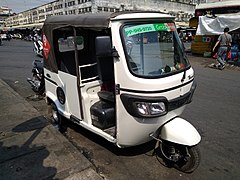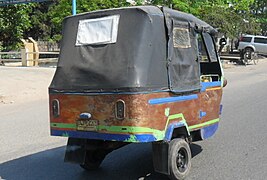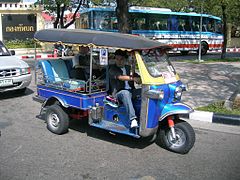Auto rickshaw

Anauto rickshawis a motorized version of thepulled rickshaworcycle rickshaw.Most have three wheels and do not tilt. They are known by many terms in various countries, includingauto,auto rickshaw,baby taxi,mototaxi,pigeon,jonnybee,bajaj,chand gari,lapa,tuk-tuk,tum-tum,Keke-napep,Maruwa,Adaidaita Sahu,3wheel,pragya,bao-bao,easy bike,andtukxi.
The auto rickshaw is a common form of transport around the world, both as avehicle for hireand for private use. They are especially common in countries withtropicalorsubtropical climatessince they are usually not fully enclosed, and they are found in manydeveloping countriesbecause they are relatively inexpensive to own and operate. There are many different auto rickshaw designs. The most common type is characterized by a sheet-metal body or open frame resting on three wheels; a canvas roof with drop-down side curtains; a small cabin at the front for the driver operatinghandlebarcontrols; and a cargo, passenger, or dual purpose space at the rear. Another type is a motorcycle that has an expanded sidecar or, less often, is pushing or pulling a passenger compartment.
As of 2019,Bajaj Autoof India is the world's largest auto rickshaw manufacturer, selling 780,000 during the 2019 fiscal year.[1]
Origin
[edit]
In the 1930s Japan, which was the most industrialized country in Asia at the time, encouraged the development of motorized vehicles including less expensive three-wheeled vehicles based on motorcycles. TheMazda-Go,a 3-wheel open "truck" released in 1931,[2]is often considered the first of what became auto rickshaws. Later that decade the JapaneseMinistry of Posts and Telecommunications of Japandistributed about 20,000 used three-wheelers to Southeast Asia as part of efforts to expand its influence in the region.[3][4][5][6]They became popular in some areas, especially Thailand, which developed local manufacturing and design after the Japanese government abolished the three-wheeler license in Japan in 1965.[7]
Production in Southeast Asia started from theknockdownproduction of theDaihatsu Midget,which was introduced in 1959.[8]An exception is the indigenously modified Philippine tricycle, which originates from theRikuoType 97 motorcyclewith a sidecar, introduced to the islands in 1941 by theImperial Japanese Armyduring World War II.[9]
In Europe,Corradino D'Ascanio,aircraft designer atPiaggioand inventor of theVespa,came up with the idea of building a light three-wheeled commercial vehicle to power Italy's post-wareconomic reconstruction.ThePiaggio Apefollowed suit in 1947.
Regional variations
[edit]Africa and the Middle East
[edit]Egypt
[edit]Locally named the "tuktuk", the rickshaw is used as a means of transportation in most parts of Egypt. It is generally rare to find in some affluent and newer parts of cities such asNew CairoandHeliopolis;and on highways due to police control and enforcement.
Gaza
[edit]Together with therecent boom of recreational facilities in Gazafor the local residents, donkey carts have all but been displaced by tuk-tuks in 2010. Due to the ban byEgyptand Israel on the import of most motorised vehicles, the tuk-tuks have had to be smuggled in parts through thetunnel networkconnecting Gaza withEgypt.[10]
Iraq
[edit]Due to extreme congestion inBaghdadand other Iraqi cities combined with the insensible cost of vehicles in relation to frequent violence, rickshaws have been imported from India in large numbers to provide taxi service and other purposes, in stark contrast to previous attitudes of thepre-U.S. 2003 invasioneras with rickshaws being disdained and sedans being held in high regard as a status symbol. Rickshaws have been noted for being instrumental in political protest revolts[11][12][13][14][15]
Madagascar
[edit]In Madagascar, man-powered rickshaws are a common form of transportation in a number of cities, especiallyAntsirabe.They are known as "posy" frompousse-pousse,meaningpush-push.Cycle rickshaws took off since 2006 in a number of flat cities likeToamasinaand replaced the major part of the posy, and are now threatened by the auto rickshaws, introduced in 2009. Provincial capitals like Toamasina, Mahajanga, Toliara, and Antsiranana are taking to them rapidly.[citation needed]They are known as "bajaji" in the north and "tuk-tuk" or "tik-tik" in the east, and are now licensed to operate as taxis.[citation needed]They are not yet allowed an operating licence in the congested, and more polluted national capital, Antananarivo.[citation needed][16][17][18]
Nigeria
[edit]
The auto rickshaw is used to provide transportation in cities all over Nigeria. Popularity and use varies across the country. In Lagos, for example, the "keke" (Hausafor bicycle) is regulated and transportation around the state's highways is prohibited while in Kano it's popularly known as "Adaidaita Sahu".[19]
South Africa
[edit]
Tuk-tuks, introduced inDurban[20]in the late 1980s enjoyed growing popularity in recent years, particularly inGauteng.[21]InCape Townthey are used to deliver groceries and, more recently, transport tourists.[22][23]

Sudan
[edit]Rickshaws, known as "Raksha" in Sudan, are the most common means of transportation, followed by the bus, in the capitalKhartoum.
Tanzania
[edit]Locally known as "bajaji", they are a common mode of transportation inDar es Salaam,and many other cities and villages.[24]
Uganda
[edit]A local delivery company called as Sokowatch in 2020 began a pilot project using electric tuk-tuks, to cut pollution.[25]
Zimbabwe
[edit]
Hende Moto EV & Taxi company was founded in 2019 by Devine Mafa, an American-Zimbabwean businessman. Hende Moto taxis were first introduced in Zimbabwe as the first car, manufactured by a Zimbabwean three-wheeler manufacturing company Hende Moto Pvt Ltd. Hende Moto Engine in a Safari fiberglass body. The first Hende Moto Taxi was introduced in Kwekwe August 2019, Zimbabwe and thereafter, Victoria Falls City came second and lastly Harare 2019. Hende Moto is also the manufacturer of the first Zimbabwean-made electric passenger three-wheeled vehicle. It operates on a lithium-ion battery that has a range of 70 miles on a 6-hour charge.
South Asia
[edit]Afghanistan
[edit]
Auto rickshaws are very common in the eastern Afghan city ofJalalabad,where they are popularly decorated in art and colors.[26]They are also popular in the northern city ofKunduz.[27]
Bangladesh
[edit]
Auto rickshaws (locally called "baby taxis" and more recently "CNGs" due to their fuel source, compressed natural gas) are one of the more popular modes of transport in Bangladesh mainly due to their size and speed. They are best suited to narrow, crowded streets, and are thus the principal means of covering longer distances within urban areas.[28]
Two-stroke engines had been identified as one of the leading sources of air pollution inDhaka.Thus, since January 2003, traditional auto rickshaws were banned from the capital; only the new natural gas-powered models (CNG) were permitted to operate within the city limits. All CNGs are painted green to signify that the vehicles areeco-friendlyand that each one has a meter built-in.[29]
India
[edit]
Most cities offer auto rickshaw service, Althoughcycle rickshawsand handpulled rickshawsare also available but rarely in certain remote areas, as all other cities began using auto rickshaws. [30]: 15, 57, 156 Many state governments have launched an initiative of women-friendly rickshaw service called thePink Rickshawsdriven by women.[31]The drivers are known as the Rickshaw-wallah,auto-wallah,tuktuk-wallahorauto-kaarain places like Kerala.
Auto rickshaws are used in cities and towns for short distances; they are less suited to long distances because they are slow and the carriages are open to air pollution.[30]: 57, 58, 110 Auto rickshaws (often called "autos" ) provide cheap and efficient transportation. Modern auto rickshaws run on electricity as government pushes for e-mobility through its FAME-II scheme,compressed natural gas(CNG) andliquified petroleum gas(LPG) due togovernmentregulations and are environmentally friendly compared to full-sized cars.[citation needed][nb 1]
To augment speedy movement of traffic, auto rickshaws are not allowed in the southern part ofMumbai.[32]
India is the location of the annualRickshaw Run.
There are two types of auto rickshaws in India. In older versions the engines were below the driver's seat, while in newer versions engines are in the rear. They normally run on petrol, CNG, ordiesel.Theseating capacityof a normal rickshaw is four, including the driver's seat. Six-seater rickshaws exist in different parts of the country, but the model was officially banned in the city ofPuneon 10 January 2003 by the Regional Transport Authority (RTA).[33]
Apart from this, modern electric auto rickshaws, which run on electric motors and have high torque and loading capacity with better speed, are also gaining popularity in India. Many auto drivers moved to electric three-wheelers as the prices of CNG or Diesel is very high and that type of auto rickshaw is much costlier compared to the electric auto rickshaw. The Government is also taking actions to convert current CNG and diesel rickshaws to electric rickshaws.[34]
CNG autos in many cities (e.g. Delhi, Agra) are distinguishable from the earlier petrol-powered autos by a green and yellow livery, as opposed to the earlier black and yellow appearance. In other cities (such as Mumbai) the only distinguishing feature is the 'CNG' print found on the back or side of the auto. Some local governments are consideringfour-stroke enginesinstead of two-stroke versions.[citation needed]
Notable auto rickshaw manufacturers in India includeBajaj Auto,Mahindra & Mahindra,Piaggio Ape,Atul Auto,Kerala Automobiles Limited,TVS MotorsandForce Motors.
In Delhi there also used to be a variant powered by aHarley-Davidsonengine called thephat-phati,because of the sound it made. The story goes that shortly afterIndependencea stock of Harley-Davidson motorbikes were found that had been used by British troops duringWorld War IIand left behind in a military storage house in Delhi. Drivers purchased these bikes, added on a gear box (probably from aWillys jeep), welded on a passenger compartment that was good for four to six passengers, and put the unconventional vehicles onto the roads. A 1998 ruling of theSupreme Courtagainst the use of polluting vehicles finally signed the death warrant of Delhi's phat-phatis.[35][36][37][38]
As of 2022[update]India has about 2.4 million battery-powered, three-wheeled rickshaws on its roads. Some 11,000 new ones hit the streets each month, creating a US$3.1 billion market. Manufacturers include Mahindra & Mahindra Ltd. and Kinetic Engineering. A prerequisite for the adoption to electric vehicles is the availability of charging stations; as of early 2024, India had 12,146 public EV charging stations operational across the country.[39]
-
CNG green auto rickshaw in New Delhi
-
A Bajaj Auto rickshaw inBangalore
-
A Piaggio Ape auto rickshaw inKerala.
-
A TVS auto rickshaw inChennai.
-
An electric rickshaw at abattery swappingpoint.
-
Three wheeler cargo auto-rickshaw used in India
-
Indian auto-rickshaw adapted withtrailer
-
Erisha electric passenger and cargo Auto rickshaws in India
Generally rickshaw fares are controlled by the government,[40]however auto (and taxi) driver unions frequently go on strike demanding fare hikes. They have also gone on strike multiple times in Delhi to protest against the government andHigh Court's 2012 order to installGPSsystems, and even though GPS installation in public transport was made mandatory in 2015, as of 2017 compliance remains very low.[41][42][43]
The 200 cc variant of theBajaj Autoauto rickshaw was used in the 2022Rickshaw Runto set the record for the world's highest auto rickshaw, over theUmling LaPass, at 5,798 meters (19,022 feet)[44][45]
Nepal
[edit]Auto rickshaws were a popular mode of transport in Nepal during the 1980s and 1990s, until the government banned the movement of 600 such vehicles in the early 2000s.[46]The earliest auto rickshaws running in Kathmandu were manufactured by Bajaj Auto.[citation needed]
Nepal has been a popular destination for theRickshaw Run.The 2009 Fall Run took place inGoa,India and ended inPokhara,Nepal.[47]
Pakistan
[edit]Auto rickshaws are a popular mode of transport in Pakistani towns[48]and are mainly used for travelling short distances within cities. One of the major manufacturers of auto rickshaws isPiaggio.The government is taking measures to convert all gasoline powered auto rickshaws to cleaner CNG rickshaws by 2015 in all the major cities of Pakistan by issuing easy loans through commercial banks.Environment Canadais implementing pilot projects inLahore,Karachi,andQuettawith engine technology developed inMississauga,Ontario, Canada that uses CNG instead of gasoline in the two-stroke engines, in an effort to combatenvironmental pollutionand noise levels.[citation needed]
In many cities in Pakistan, there are also motorcycle rickshaws, usually called "chand gari" (moon car) or "chingchi", after the Chinese companyJinan Qingqi Motorcycle Co. Ltdwho first introduced these to the market.[citation needed]
There are many rickshaw manufacturers in Pakistan. Lahore is the hub of CNG auto rickshaw manufacturing. Manufacturers include: New Asia automobile Pvt, Ltd; AECO Export Company; STAHLCO Motors; Global Sources; Parhiyar Automobiles; Global Ledsys Technologies; Siwa Industries; Prime Punjab Automobiles; Murshid Farm Industries; Sazgar Automobiles; NTN Enterprises; and Imperial Engineering Company.
Sri Lanka
[edit]
Auto rickshaws, commonly known as three-wheelers, tuk-tuks (Sinhala:ටුක් ටුක්,pronounced[ṭukṭuk]), autos, or trishaws can be found on all roads inSri Lankatransporting people or freight. Sri Lankan three-wheelers are of the style of the light Phnom Penh-type. Most of the three-wheelers in Sri Lanka are a slightly modified IndianBajajmodel, imported from India though there are few manufactured locally and increasingly imports from other countries in the region and other brands of three-wheelers such asPiaggio Ape.Three-wheelers were introduced to Sri Lanka for the first time around 1979 byRichard Pieris & Company.As of mid-2018,[update]a new gasoline powered tuk-tuk typically costs aroundUS$4,300,while a newly introduced Chinese electric model cost aroundUS$5,900.[49]Since 2008, the Sri Lankan government has banned the import of all 2-stroke gasoline engines due to environmental concerns.[49]Ones imported to the island now are four-stroke engines. Most three-wheelers are available as hired vehicles, with few being used to haul goods or as private company or advertising vehicles. Bajaj enjoys a virtual monopoly in the island, with its agent being David Pieries Motor Co, Ltd.[50]A few three-wheelers in Sri Lanka have distance meters. In the capital city it is becoming more and more common. The vast majority of fares are negotiated between the passenger and driver. There are 1.2 million trishaws in Sri Lanka and most are on financial loans.
In Sri Lanka, tourists are able to drive a tuktuk. Through the Automobile Association of Ceylon, tourists are able to get a temporary Recognition Permit which allows them to drive a three-wheeler legally.[51][self-published source?]
Southeast Asia
[edit]-
Tuktuks andpalmyra palmson the Mekong bank in Thakhek, Laos
-
Tuk-tuk taxi sidecar in Laos
-
Tuk-tuk,Phnom Penh,Cambodia
Cambodia
[edit]InCambodia,a passenger-carrying three-wheeled vehicle is known asរ៉ឺម៉កrœmâkfrom the Frenchremorque.It is a widely used form of transportation in the capital of Phnom Penh and for visitors touring theAngkortemples inSiem Reap.Some have four wheels and is composed of a motorcycle (which leans) and trailer (which does not). Cambodian cities have a much lower volume of automobile traffic than Thai cities, and tuk-tuks are still the most common form of urban transport. There are more than 6,000 tuk-tuks in Phnom Penh, according to the Independent Democracy of Informal Economy Association (IDEA), a union that represents tuk-tuk drivers among other members.[52]
Indonesia
[edit]InIndonesia,auto rickshaws are popular inJakartaasBajay,Java,MedanandGorontaloasBentor,and some parts ofSulawesiand other places in the country. In Jakarta, the auto rickshaws are calledBajayorBajajand they are the same to as the ones in India but are colored blue (for the ones which useCompressed natural gas) and orange (for the ones which use normal gasoline fuel).[53]The blue ones are imported from India with the brand ofBajajandTVSand the orange ones are the old design from 1977. The orange ones uses two-stroke engines as their prime mover, while the blue ones use four stroke engines. The orange bajaj has been banned since 2017 due to emission regulations.[54][53]The Bajaj is one of the most popular modes of transportation in the city. Outside of Jakarta, thebentor-style auto rickshaw is ubiquitous, with the passenger cabin mounted as a sidecar (like in Medan) or in-front (like the ones in some parts of Sulawesi) to a motorcycle.
-
Bentor in North Sumatra
-
Bentor inTana Toraja,South Sulawesi
-
2-stroke Bajaj inBanjarmasin,South Kalimantan
-
4-stroke Bajaj inJakarta.
-
Former 2-stroke orange Bajaj inJakarta.
Philippines
[edit]In thePhilippines,a similar mode ofpublic transportis the "tricycle"(Filipino:traysikel;Cebuano:traysikol).[55]Unlike auto rickshaws, however, it has amotorcycle with a sidecarconfiguration and a different origin. The exact date of its appearance in the Philippines is unknown, but it started appearing after World War 2, roughly at the same time as the appearance of thejeepney.It is most likely derived from theRikuoType 97military motorcycle used by theImperial Japanese Armyin the Philippines starting at 1941. The motorcycle was essentially a licensed copy of aHarley-Davidsonwith a sidecar.[9]However, there is also another hypothesis which places the origin of the tricycle to the similarly built "trisikad",a human-poweredcycle rickshawbuilt in the same configuration as the tricycle. However, the provenance of the trisikad is also unknown. Prior to the tricycles and trisikad, the most common means of mass public transport in the Philippines is a carriage pulled by horses orcarabaosknown as thekalesa(calesaorcarromatainPhilippine Spanish).[56]Thepulled rickshawnever gained acceptance in the Philippines. Americans tried to introduce it in the early 20th century, but it was strongly opposed by local Filipinos who viewed it as an undignified mode of transport that turned humans into "beasts".[57]
The design and configuration oftricyclesvary widely from place to place, but tends towards rough standardization within each municipality. The usual design is a passenger or cargosidecarfitted to a motorbike, usually on the right of the motorbike. It is rare to find one with a left sidecar. A larger variant of the tricycle with the motorcycle in the center enclosed by a passenger cab with two side benches is known as a "motorela". It is found on the islands ofMindanao,Camiguin,andBohol.[58]Another notable variant is the tricycles of theBatanes Islandswhich have cabs made from wood and roofed with thatchedcogon grass.[59]InPagadian City,tricycles are also uniquely built with the passenger cab slanting upwards, due to the city's streets that run along steep hills.[60]
Tricycles can carry three passengers or more in the sidecar, one or twopillionpassengers behind the driver, and even a few on the roof of the sidecar. Tricycles are one of the main contributors to air pollution in the Philippines,[61][62]which account for 45% of allvolatile organic compoundemissions[63]since majority of them employ two-stroke engines. However, some local governments are working towards phasing out two-stroke tricycles for ones with cleaner four-stroke engines.[61][64]
Tuk-Tuks have now been accepted as Three-Wheeled Vehicles by theLand Transportation Office (Philippines)as distinct from tricycles and are now seen in Philippine streets. Electric versions are now seen especially in the city of Manila where they are called e-trikes.[65]Combustion engine tuktuks are locally distributed byTVS MotorsandBajaj Autothrough dealerships[66]
-
Motorized tricycle,Dumaguete
-
7-passenger tricycle with large sidecar, province ofAklan
-
Tricycle stand, Banaue Municipal Town
Thailand
[edit]The auto rickshaw, called tuk-tuk (Thai:ตุ๊ก ๆ,pronounced[túktúk]) in Thailand, is a widely used form of urban transport inBangkokand other Thai cities. The name isonomatopoeic,mimicking the sound of a small (often two-cycle) engine. It is particularly popular wheretraffic congestionis a major problem, such as in Bangkok andNakhon Ratchasima.In Bangkok in the 1960s, these were called samlaws, and it is still popularly called that today.
Bangkok and other cities in Thailand have many tuk-tuks which are a more open variation on the Indian auto rickshaw. About 20,000 tuk-tuks were registered as taxis in Thailand in 2017.[67]Bangkok alone is reported to have 9,000 tuk-tuks.[68]
Tuk-tuk hua kob (ตุ๊ก ๆ หัวกบ,pronounced[túktúkhua̯kop̚],literally: frog-headed tuk tuk) is a unique tuk tuk with a cab looking like a frog's head. OnlyPhra Nakhon Si AyutthayaandTranghave vehicles like this.[69][70]
in 2018, MuvMi, an electric tuk-tukride hailingservice launched in Bangkok.[71]
-
Tuk-tuk in Bangkok
-
Police tuk-tuk,Chiang Mai
-
Electrictuk-tuk inChiang Mai
-
Tuk-tuk hua kob, Phra Nakhon Si Ayutthaya
East Asia
[edit]China
[edit]
Various types of auto rickshaw are used around China, where they are called sān lún chē ( xe ba bánh ) and sometimes sān bèng zǐ ( xe ba bánh ), meaning three wheeler or tricycle. They may be used to transport cargo or passengers in the more rural areas. However, in many urban areas the auto rickshaws for passengers are often operated illegally as they are considered unsafe and an eyesore.[72][73]They are permitted in some towns and cities, however. The Southeast Asian word tuk tuk is transliterated as dū dū chē ( đô đô xe, or beep beep car) in Chinese.[74]
Europe
[edit]France
[edit]A number of tuk-tuks (250 in 2013 according to the Paris Prefecture) are used as an alternative tourist transport system in Paris, some of them being pedal-operated with electric motor assist. They are not yet fully licensed to operate and await customers on the streets. Vélotaxis were common during the Occupation years in Paris due to fuel restrictions.[75]
Italy
[edit]
Auto rickshaws have been commonly used in Italy since the late 1940s, providing a low-cost means of transportation in the post–World War II years when the country was short of economic resources. ThePiaggio Ape(Tukxi), designed byVespacreatorCorradino D'Ascanioand first manufactured in 1948 by the Italian companyPiaggio,though primarily designed for carrying freight has also been widely used as an auto rickshaw. It is still extremely popular throughout the country, being particularly useful in the narrow streets found in the center of many little towns in central and southern Italy. Though it no longer has a key role in transportation, Piaggio Ape is still used as a minitaxi in some areas such as the islands ofIschiaandStromboli(on Stromboli no cars are allowed). It has recently been re-launched as a trendy-ecological means of transportation, or, relying on the role the Ape played in the history of Italian design, as a promotional tool.
Portugal
[edit]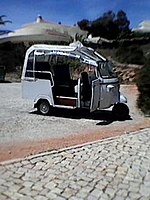
Tuk Tuks are used in the main touristic cities and regions of the country, specially inLisbonand the sunny region ofAlgarve,as a novel form of transport for visitors during the tourist season.
United Kingdom
[edit]In 2006 a British travel writer –Antonia Bolingbroke-Kent– and her friend Jo Huxster travelled 12,561 miles (20,215 km) with an auto rickshaw fromBangkoktoBrighton.With this 98 days' trip they set aGuinness World Recordfor the longest journey ever with an auto rickshaw.[citation needed] In October 2022,Gwentpolice spent £40,000 on four tuk tuk vehicles in order to help fight crime.[76]
Montenegro
[edit]Tuk Tuk Montenegro has implemented tours withelectric Tuk TuksinKotor,Montenegroin 2018.[77]
The Americas
[edit]
El Salvador
[edit]Themototaxiormotois the El Salvadoran version of the auto rickshaw. These are most commonly made from the front end and engine of a motorcycle attached to a two-wheeled passenger area in back. Commercially produced models, such as the IndianBajajbrand, are also employed.[citation needed]
Guatemala
[edit]In Guatemala tuk-tuks operate, both as taxis and private vehicles, inGuatemala City,around the island town ofFlores,Peten,in the mountain city ofAntigua Guatemala,and in many small towns in the mountains. In 2005 the tuk-tuks were prevalent in theLago de Atitlántowns ofPanajachelandSantiago Atitlán.While tuk-tuks continue to serve as a prevalent form of transportation in Antigua Guatemala, their use throughout the country as a whole has declined.
United States
[edit]In the 1950s and 1960s, theUnited States Post Office(replaced in 1971 by theUnited States Postal Service) used theWestCoaster Mailster,a close relative of the tuk-tuk.[78]Similar vehicles remain in limited use for parking enforcement, mall security, and other niche applications. After a short time on the market (Mid-2000s to 2008) in the United States,[79]the vehicles failed to gain popularity in the United States, and as a result, are no longer available. The ManufacturerBajajcited the manual transmissions aboard the three-wheelers as the reason for poor sales. As a result of modifications that made the machinesEPAandDOTcompliant, the vehicles that were sold are still street-legal.[80]

Cuba
[edit]In Cuba, the autorickshaws are small and look like a coconut, hence the nameCocotaxi.

Peru
[edit]In Peru, a version of this vehicle is called a motocar[81]or mototaxi.[82]
Fuel efficiency and pollution
[edit]In July 1998, theSupreme Court of Indiaordered the government of Delhi to implement CNG orLPG(Autogas)fuelfor all autos and for the entire bus fleet in and around the city. Delhi's air quality has improved with the switch to CNG. Initially, auto rickshaw drivers in Delhi had to wait in long queues for CNG refueling, but the situation improved following an increase in the number of CNG stations. Gradually, many state governments passed similar laws, thus shifting to CNG or LPG vehicles in most large cities to improve air quality and reduce pollution. Certain local governments are pushing forfour-stroke enginesinstead of two-stroke ones. Typicalmileagefor an Indian-made auto rickshaw is around 35 kilometres per litre (99 mpg‑imp;82 mpg‑US) of petrol. Pakistan has passed a similar law prohibiting auto rickshaws in certain areas. CNG auto rickshaws have started to appear in huge numbers in many Pakistani cities.[citation needed]
In January 2007 the Sri Lankan government also banned two-stroke trishaws to reduce air pollution. In the Philippines[83]there are projects to convert carburated two-stroke engines to direct-injected viaEnvirofittechnology. Research has shown LPG or CNG gas direct-injection can be retrofitted to existing engines, in similar fashion to the Envirofit system.[84]InVigan Citymajority of tricycles-for-hire as of 2008 are powered by motorcycles with four-stroke engines, as tricycles with two-stroke motorcycles are prevented from receiving operating permits. Direct injection is standard equipment on new machines in India.[85][86]
In March 2009 an international consortium coordinated by theInternational Centre for Hydrogen Energy Technologiesinitiated a two-year public-private partnership of local and international stakeholders aiming at operating a fleet of 15 hydrogen-fueled three-wheeled vehicles in New Delhi'sPragati Maidancomplex.[87]As of January 2011, the project was nearing completion.[citation needed]
Hydrogen internal combustion(HICV) use in three-wheelers has only recently being started to be looked into, mainly by developing countries, to decrease local pollution at an affordable cost.[88][89]At some point,Bajaj Automade a HICV auto rickshaw together with the company "Energy Conversion Devices".[90]They made a report on it called "Clean Hydrogen Technology for 3-Wheel Transportation in India" and it stated that the performance was comparable with CNG autos. In 2012, Mahindra & Mahindra showcased their first HICV auto rickshaw, called the Mahindra HyAlfa.[90]The development of the hydrogen-powered rickshaw happened with support from theInternational Centre for Hydrogen Energy Technologies.
World records
[edit]On 16 September 2022, at 11:04 a.m. (Indian Standard Time), a Canadian team (Greg Harris and Priya Singh) and a Swiss team (Michele Daryanani and Nevena Lazarevic) set the world record for the highest altitude at which an auto rickshaw has ever been driven. The two teams set the record by driving to the summit ofUmling LaPass at an altitude of 5,798 meters (19,022 feet).[91]
The two teams were participating in theRickshaw Run(Himalayan Edition), an event promoted by The Adventurists, where teams drive auto rickshaws from theThar deserttown ofJaisalmerin Rajasthan to theHimalayantown ofLehinLadakh.Rickshaw Run teams are given the start and finish lines, but are otherwise unsupported and left to their own navigational choices in completing the approximately 2,300 km journey.
The road at Umling La Pass was constructed by India's Border Roads Organization and completed in 2017. Guinness World Records certified the road as the highest motorable road in the world.[92]
See also
[edit]- E-tricycle
- Fuel gas-powered scooter
- Formic acid vehicle:a type of hydrogen-based vehicle
- Jeepney
- Rickshaw (disambiguation)
Explanatory notes
[edit]- ^Typicalfuel economyfor an Indian-made auto rickshaw is around 35 kilometres per litre (99 mpg‑imp;82 mpg‑US) ofpetrol.[citation needed]
References
[edit]- ^"Bajaj Auto in top gear".Fortune India.November 2019.
- ^"Great Cars of Mazda: Mazda-Go 3-wheeled Trucks (1931〜)".Mazda Motor Corporation. Archived fromthe originalon 2019-02-09.
- ^ミゼット vật ngữ mộc thôn tin chi cao nguyên hiệu sách(Nobuyuki Kimura "Story of Midget", Published on 10 November 1998)
- ^Daihatsu Motor Co., Ltd. public relations section
- ^NPOみらいネットワーク gửi phụ toạ đàm, ホテル quan quang học khoa の học sinh に ngày タイ quan hệ をピーアール Nhật Bản で の nhận chức cơ hội に quan tâm.Bangkok Shuho(in Japanese). 2007-11-19. Archived fromthe originalon 2009-04-30.
- ^/index.php?option=com_content&view=article&id=321:2009-11-30-05-34-59&catid=54:2009-09-09-07-52-31&Itemid=232 Royal Thai Embassy Tokyo, JapanNhật Bản sinh まれ の タイ の トゥクトゥク (Tuk-Tuk of Thailand was born in Japan.)
- ^"Tuk-Tuk, Thailand's most notorious mode of transport - deSIAM".desiam.Archived fromthe originalon 2020-09-23.Retrieved2020-03-26.
- ^"【ダイハツ ミゼット DKA / DSA hình 】 hoảng phó 3 luân スクーター hình トラック kiểu cũ thương dùng xe đồ giam".route0030.blog.fc2.
- ^ab"The History of the Philippines Tricycle".Tuk Tuk 3 Wheelers.22 November 2018.Retrieved25 March2020.
- ^"Tuk Tuks replace mules on Gaza streets".Maan News Agency. 12 September 2010.Retrieved2011-03-22.
- ^"Mundane autos in India, hero tuk-tuks in Iraq".Deccan Herald.25 November 2019.Retrieved31 January2024.
- ^Shukla, Srijan (26 November 2019)."How Indian manufactured auto-rickshaws became a symbol of Iraqi protests".ThePrint.Retrieved31 January2024.
- ^Alhas, Ali Murat."In congested Baghdad, Iraqis turn to 3-wheel 'tuk-tuks'".Anadolu Agency.
- ^Vitalone, Vivi (14 November 2024)."How tuk-tuk drivers became the unlikely heroes of Iraq's popular revolt".NBC News.Retrieved31 January2024.
- ^Salim, Mustafa; Berger, Miriam (1 November 2024)."The humble three-wheeled tuk-tuk has become the symbol of Iraq's uprising".The Washington Post.Retrieved31 January2024.
- ^Jay Heale; Zawiah Abdul Latif (2008).Madagascar, Volume 15 of Cultures of the World Cultures of the World – Group 15(2 ed.). Marshall Cavendish. pp. 75–76.ISBN978-0761430360.
- ^Madagascar Travel Guide(7 ed.). Lonely Planet. 2012.ISBN978-1743213018.Retrieved2013-04-13.
- ^"'Bajaj' à Mahajanga: Entre 70 et 100 clients par jour ".Midi Madagasikara(in French). 2014-05-30.
- ^Odunsi, Wale (16 November 2017)."Lagos bans okada, keke from 520 roads, areas [Full list]".Daily Post.
- ^"Durban offers beaches and culteral diversity".Zululand Tourism. Archived fromthe originalon 22 May 2022.Retrieved22 September2015.
Tuk Tuks: Mororised, covered tricycles which carry up to six passengers. Ideal for short 'hops' between the beachfront and city centre.
- ^Steyn, Lisa (18 January 2013)."Cheap-cheap tuk-tuk taxis take over Jozi".Retrieved22 September2015.
Tuk-tuks, also known as auto rickshaws, are becoming an increasingly common sight on South Africa's roads because people are trying to travel short distances at lower costs than driving and at less risk than walking.
- ^Ryan, Tamlyn (September 2016)."Tuk-tuks are coming to Cape Town".Inside Guide. Archived fromthe originalon 2017-08-14.Retrieved2017-03-18.
- ^Govender, Suthentira (2017-01-25)."Buddibox grocery delivery programme set to create 10,000 young entrepreneurs in Gauteng".TimesLIVE.
- ^Kalagho, Kenan (13 February 2012)."Tanzania: Bajaji, Dar es Salaam's Indispensable Taxi".AllAfrica.Retrieved22 September2015.
Until the year 2010 Dar es Salaam had no room for the Indian Bajaji and or a tricycle to be used as a means of transporting passengers. Today it is a common feature around Dar es Salaam.
- ^Kuhudzai, Remeredzai Joseph (4 December 2020)."Gayam Motor Works & Sokowatch Launch East Africa's First Commercial Electric Tuk-Tuks".CleanTechnica.
- ^McHugh, John D."In Taliban country: inside the city of Jalalabad".The Irish Times.
- ^"Auto-rickshaws clogging Kunduz arteries".pajhwok.23 May 2012.
- ^Lane, Jo."Asia's love affair with the rickshaw".asiancorrespondent.Archived fromthe originalon 2015-07-13.Retrieved2015-07-30.
- ^"Police purge for Dhaka rickshaws".BBC News.20 December 2002.Retrieved2011-03-22.
- ^abPippa de Bruyn; Keith Bain; David Allardice; Shonar Joshi (2010).Frommer's India(Fourth ed.). John Wiley and Sons.ISBN978-0470645802.
- ^"Pink Auto Rickshaw Project"(PDF).17 July 2019.
- ^Pippa de Bruyn; Keith Bain; David Allardice; Shonar Joshi (2010).Frommer's India(Fourth ed.). John Wiley and Sons. p.110.ISBN978-0470645802.
- ^"Six seater rickshaws banned in city".Times of India.25 September 2003.Retrieved2014-01-11.
- ^"Patna: Transport department to ban all diesel-run buses, auto-rickshaws from April 1".India Today.29 March 2022.Retrieved2022-03-29.
- ^"Remembering Delhi's phat-phatis | India News".The Times of India.
- ^"Domain parked by OnlyDomains".olddelhiheritage.in.18 September 2022.
- ^"The Phatphatis of Delhi".23 September 2011.
- ^"Phat Phatis of Delhi – Toothless Blog – MouthShut".mouthshut.
- ^"12,146 public EV charging stations operational across the country".pib.gov.in.Retrieved2024-04-16.
- ^"Maharashtra Govt refuses to increase autorickshaw, taxi fares".newKerala.UNI. Archived fromthe originalon 2013-05-18.
- ^"Autos, taxis in Delhi to go on strike today demanding fare hike".India Today.15 October 2012.Retrieved2017-02-19.
- ^"Delhi High Court Directs City Auto-Rickshaws To Install GPS".Medianama.28 September 2012.Retrieved2017-02-19.
- ^"GPS installation in public transport becomes mandatory".Times of India.2 June 2015.Retrieved2017-02-19.
- ^"Auto Rickshaws Set Highest Altitude Drive Record at 19,024 Feet on Umling La Pass".22 October 2022.
- ^"Auto rickshaws drive on Umling La Pass, the highest motorable road, to set world record at 19,024 feet".MSN.27 October 2022.
- ^"Nepal Government decides to ban 3 wheeler auto rickshaws from Nepal's road".BBC. 28 July 1999.Retrieved2011-12-06.
- ^"Rickshaw Run on 3 Wheelers from Goa, India to Pokhara, Nepal".The National. 29 August 2009.Retrieved2011-12-06.
- ^Sebastian Abbot, Associated Press (8 February 2013)."Eye-Catching Rickshaws Promote Peace in Pakistan".ABC News.Retrieved2013-04-13.
- ^abRanasinghe, A.K. (3 September 2018)."Can He Convince Sri Lankan Tuk-Tuk Owners to Go Green?".OZY.Archived fromthe originalon 3 September 2018.Retrieved3 September2018.
Tuk-tuks play a vital role in urban Sri Lanka's passenger transport system, providing what traffic experts call "last mile" service. Police and government workers rely on them too to navigate congested streets. In rural Sri Lanka, they are everything from taxi to ambulance.
- ^"Bajaj ready with 4-stroke autos for SL".Indiacar.net. Archived fromthe originalon 2009-06-27.Retrieved2010-04-03.
- ^"Renting & Driving a Tuk Tuk in Sri Lanka {Full 2022 Guide!}".
- ^Wilkins, Emily (19 February 2014)."New Futuristic Tuk-Tuks Arrive on the Streets of Phnom Penh".The Cambodia Daily.Archived fromthe originalon 30 January 2015.Retrieved30 January2015.
- ^ab"Bajaj Oranye Menunggu Giliran Dimusnahkan".Republika Online(in Indonesian). 7 January 2016.Retrieved26 May2018.
- ^Damarjati, Danu (4 July 2017)."Dishub DKI: Bulan Ini, Bajaj Merah Harus Segera Jadi Biru"[Jakarta DOT: Red Bajajs must turn Blue this month] (in Indonesian).Retrieved28 December2022.
- ^"Motorcycles and tricycles".Utrecht Faculty of Education. Archived fromthe originalon 7 March 2009.Retrieved2009-03-14.
- ^"Filipino Icon: Tricycle and Pedicab".FFE Magazine.29 December 2016.Retrieved25 March2020.
- ^Pante, Michael D. (14 August 2014)."Rickshaws and Filipinos: Transnational Meanings of Technology and Labor in American-Occupied Manila".International Review of Social History.59(S22): 133–159.doi:10.1017/S0020859014000315.
- ^"Tricycle, Motorela & Habal-Habal".Silent Gardens.Retrieved25 March2020.
- ^Corsino, Nikka (24 October 2013)."A day on Sabtang Island in Batanes".GMA News Online.Retrieved25 March2020.
- ^"WATCH: What makes Pagadian tricycles unique".Rappler.23 January 2017.Retrieved25 March2020.
- ^ab"Tricycles in the Philippines".cleanairasia.org. Archived fromthe originalon 10 June 2018.Retrieved7 January2019.
- ^Taruc, Paolo (25 March 2015)."Tricycles: As iconic as jeepneys and just as problematic".CNN Philippines.Archived fromthe originalon 7 January 2019.Retrieved7 January2019.
- ^Felongco, Gilbert P. (22 November 2015)."Philippines: Tricycles and motorcycles responsible for 45 per cent of harmful emissions".Gulf News.Retrieved7 January2019.
- ^"Mandaluyong City 2-Stroke Replacement Project".cleanairasia.org. Archived fromthe originalon 1 October 2020.Retrieved7 January2019.
- ^"E.R.A.P. Manila electric tricycle project – Second batch of beneficiaries ready".bemac-philippines.
- ^"TVS King Deluxe Three Wheeler Vs Tricycle".Tuk Tuk 3-Wheelers.20 October 2019.
- ^Wattanasukchai, Sirinya (2 February 2017)."With our tuk tuks, let's copy the Dutch".Bangkok Post.Retrieved2 February2017.
- ^"Thailand government says Bangkok has too many 'tuk-tuks'".Asian Correspondent.2016-04-15. Archived fromthe originalon 2016-04-26.Retrieved2016-04-15.
- ^"Frog-headed Tuk Tuk, Symbol of Aytthaya".Go Ayutthaya.Retrieved2019-05-30.
- ^Muangkaew, Methee (2013-02-19)."Tuk-tuk 'endangered species' in Trang".Bangkok Post.Retrieved2019-05-30.
- ^"MuvMi".ThailandMagazine.2022-02-15.Retrieved2022-06-18.
- ^"Minh châu trên đường quy mô to lớn chờ xe khách đội nguy hiểm đi ngược chiều đón khách".Châu Giang báo chiều.3 November 2009. Archived fromthe originalon 2015-04-04.
- ^"[ Thiên Tân ] đối mặt" xe ba bánh "Thỉnh ngài lớn tiếng nói" không "".auto sohu.
- ^"Đông Nam Á xe ba bánh".Global Voices.25 March 2012.
- ^"A Paris, les tuk-tuks fleurissent... tout comme les PV".La Dépêche(in French). Toulouse. AFP. 2013-08-20.
- ^"Gwent Police spend £40,000 on crime-fighting tuk-tuks".27 October 2022.Retrieved21 November2022.
- ^"A little bit about us".Tuk Tuk Montenegro.Retrieved2022-01-12.
- ^"National Postal Museum".25 August 2009. Archived fromthe originalon 25 August 2009.
- ^"Tuk Tuk USA gets DOT and EPA approval".Autoblog.
- ^"Bajaj 3-Wheeler is now off the U.S. market".Autoblog.
- ^"Motocar".Perú Motor.Archived fromthe originalon 3 October 2018.
- ^Tony Dunnell (28 July 2017)."A Traveler's Guide to Mototaxis in Peru".tripsavvy.Retrieved27 November2017.
- ^"Envirofit's Tricycle Retrofit Program Funded".Colorado State University. 19 May 2006. Archived fromthe originalon 29 September 2011.Retrieved2011-03-22.
- ^"Microsoft Word – SETC_LPG2T.doc"(PDF).Retrieved2010-04-03.
- ^"Bajaj rolls out low-emission fuel-efficient autorickshaw".Business Line.The Hindu. 2007-12-09.Retrieved2010-04-03.
- ^"Bajaj Begins Production of 2-Stroke Direct-Injection Auto Rickshaw".Green Car Congress. 2007-05-18.Retrieved2010-04-03.
- ^"A fleet of hydrogen rickshaws to circulate in New Delhi by 2010".International Centre for Hydrogen Energy Technologies. Archived fromthe originalon 2011-07-28.Retrieved2011-03-22.
- ^"Hydrogen-Fueled Internal Combustion Engines, see page 7".
- ^Clean Hydrogen Technology for 3-Wheel Transportation in India
- ^ab"India Showcases Hydrogen Fuel Auto-Rickshaws |".21 February 2012.
- ^"Auto rickshaws take world's highest road to set world record".
- ^"Highest Altitude Road".
External links
[edit]- The India 1000– an article inWiredabout auto rickshaw racing



